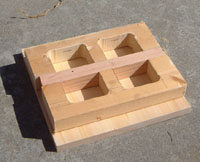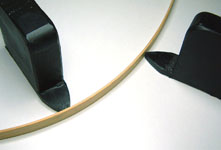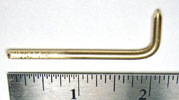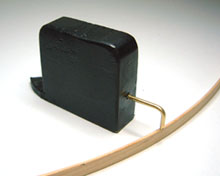Simple
Spline ducks
by Derek Waters
Making Spline
ducks.
So you've built a boat or two, and your creative juices
are flowing. Time to draw your own design. Time for splines
and ducks.
 After a bit of home
boat-building, drafting splines are usually in plentiful
supply - there are bound to be one or two candidates amongst
all those scrapwood strips lying near the saw. What's needed
are modestly priced spline-weights (or ducks) to keep the
battens in position on the drawing surface.
After a bit of home
boat-building, drafting splines are usually in plentiful
supply - there are bound to be one or two candidates amongst
all those scrapwood strips lying near the saw. What's needed
are modestly priced spline-weights (or ducks) to keep the
battens in position on the drawing surface.
These ones are not as elegant as the commercially made product,
but they work every bit as well, and the price is right.
Most of what's needed is probably out there in the 'boatshop'.
Materials:
These quantities
assume you are making four 'ducks' - although I was taught
you can define any curve with only three points the spline
doesn't always agree and that fourth duck often proves handy.
20 lb. or so of lead
wheel-balancing weights, collected from local tire-fitters
12" length of one eighth inch diameter brass wire from
model-shop. Alternatively, cuphooks from the hardware store.
Scrap wood as follows:
| Dim.X |
Dim.Y |
Length/Thickness |
Material |
| 1.5 in. |
3.5 in. |
18 in. |
'2 x 4' |
| 1.5 in. |
1.5 in. |
9 in. |
'2 x 2' |
| 9 in. |
9 in. |
1/2 in. or thicker |
G1S ply |
| 16 in. |
1 in. |
1/4 in. |
G1S ply |
Small quantity of
epoxy resin and filler
Waterglass (sodium silicate). (Not essential. Available
from marine stores, or online from Budget Castings supply or Skylighter)
silicone tape or clear silicone bathroom sealant type 'goop'
leftover paint
Making the
mold:
Rip one of the rounded-over
edges off the piece of 2 by 4. Take care to ensure that
the resulting face makes a 90 degrees angle with the flat
of the '2 by'.
 Now cut out four
'bites' in from the squared edge as shown. The dimensions
shown will give a 'duck' weighing about four pounds.
Now cut out four
'bites' in from the squared edge as shown. The dimensions
shown will give a 'duck' weighing about four pounds.
A sabresaw or a bandsaw would be the quickest way, but a
coping saw will work. If none of these tools are available
just mark in from the corners and drill a large radius hole,
saw down with a handsaw then clear out the waste with a
chisel.
 You should end up with something like this.
You should end up with something like this.
Your 2 by 4 'comb' is one and a half inches thick. On the
inside face of each of the bites, mark a line one inch from
the large face. This will be your 'pour to' level. Cut the
'comb' in half, giving you two capital 'E' shapes.
Make sure your scrap of 2 by 2 has square edges by carefully
ripping off any round-over. The width of this piece isn't
very important as long as it remains wide enough to have
a screw driven into it without splitting. Mark a centreline
on the scrap ply and attach the 2 by 2 down that line. Drive
screws or nails through the base and into the wood, countersinking
or punching as necessary.
 Now attach the two 'E' shapes as shown. Make sure they fit
snugly against the centre strip. The lead will be poured
into the four resulting cavities to a depth of one inch.
Remember to position the 'E's so that the 'pour level' line
you marked earlier is in the right place, one inch up from
the plywood bottom of the mold.
Now attach the two 'E' shapes as shown. Make sure they fit
snugly against the centre strip. The lead will be poured
into the four resulting cavities to a depth of one inch.
Remember to position the 'E's so that the 'pour level' line
you marked earlier is in the right place, one inch up from
the plywood bottom of the mold.
If you managed to find some waterglass, paint it onto the
inside surfaces of the mold. The waterglass helps protect
the wood of the mold against the heat. Set the mold aside
until the waterglass has completely dried. Dryness is very
important - at pouring time any hint of moisture will be
turned instantly to steam, which will fire gobbets of molten
lead everywhere. Be absolutely sure the
mold is dry before proceeding.
A few further
words on safety:
The fumes from molten
lead are a health hazard. Do not breathe or sniff them.
Melt the lead outdoors, over a BBQ or camp stove. A cartridge
mask is a good idea. For a one-off process like this, a
combination of simply keeping upwind and holding your breath
should suffice.
Lead is toxic - use a scrap pan to do the melting, and make
sure that it cannot be inadvertently used for food preparation
by someone else in the future. Buy a pan for a dollar at
a charity store then if in doubt, crush it afterwards.
Lead is (of course) heavy - make sure that scrap pan has
a solidly attached handle. The old pan I use has a scrap
wood handle I fitted to replace a shaky original. You do
not want to be standing holding a handle while a pan of
molten metal falls on your feet.
Don't be pouring lead wearing shorts and a T-shirt - Long
sleeves, gloves and boots are the order of the day. Wear
safety glasses or goggles. If you don't have a cartridge
mask, at least wear a disposable mask to guard against splashes.
Pouring the
ducks:
Set up your mold
on a sturdy box or old table. Use a spirit level to ensure
that the mold is not sitting tilted. Find an old coffee
can or similar metal scrap receptacle to dump dross into.
Get into your safety gear.
Fill your melting pan with tire weights. Usually, tire weights
are pretty dirty, but there isn't much point cleaning them
as all the dirt will either burn off or float on top of
the lead. I use a dollar-store sieve-spoon to skim off the
dross and steel clips.
It will take a while for the first weight to melt, but once
there is a pool of molten metal in the pan the other weights
will slump and melt fairly quickly. Additional weights can
be added to the molten pool, being careful to avoid splashing.
Once all the metal in the pan is molten and all the dross
has been skimmed off, carefully pour the first 'duck'. Pour
it all in one go all the way up to the line you marked earlier,
swiftly but carefully. Once removed from the heat source
the lead will want to set up, especially where it is thinned
out on the side of the pan. When you return the pan to the
heat the lead will re-liquefy and more lead can be added
ready for the next 'duck'. Repeat the melt, skim, pour cycle
until all your 'ducks' are filled up to the same one inch
pour level. Turn off the heat and leave the mold alone for
a while. The lead will set up very quickly, but will retain
heat for a long time.
After an hour or two, remove the screws holding the mold
together and lift out your 'ducks'. Some shrinkage is to
be expected. Any hollow on the exposed 'pour' face can be
filled with thickened epoxy. Any odd bumps or irregularities
can be shaved off with normal woodworking tools.
Assembly:
 While you are waiting for the lead to cool, cut four pieces
of quarter inch ply each four inches long by one inch wide.
These will be the bases for the ducks. Cut, sand or file
one end of each piece into a blunt chisel shape. This 'pointed
end gives a single point contact if you are using the ducks
pushed against the side of the batten.
While you are waiting for the lead to cool, cut four pieces
of quarter inch ply each four inches long by one inch wide.
These will be the bases for the ducks. Cut, sand or file
one end of each piece into a blunt chisel shape. This 'pointed
end gives a single point contact if you are using the ducks
pushed against the side of the batten.
 Cut four pieces of the brass rod, each two and three quarters
of an inch long. File a chisel point onto one end of each
section of rod. Measure back from the point five eighths
of an inch and using pliers or a vice bend the chisel point
over to ninety degrees as shown. Run the hacksaw blade across
the long end of the rod to give some tooth for the adhesive.
These will be the hooks which press down on top of the batten
to hold it 'mid-line'. Cup hooks or large bronze nails with
the heads cut off can be substituted here.
Cut four pieces of the brass rod, each two and three quarters
of an inch long. File a chisel point onto one end of each
section of rod. Measure back from the point five eighths
of an inch and using pliers or a vice bend the chisel point
over to ninety degrees as shown. Run the hacksaw blade across
the long end of the rod to give some tooth for the adhesive.
These will be the hooks which press down on top of the batten
to hold it 'mid-line'. Cup hooks or large bronze nails with
the heads cut off can be substituted here.
 Decide what size of batten you will be pinning down with
the brass hook-end of your ducks. I've found three eighths
of an inch by one eighth of an inch to work well. Using
the hooks as a guide, measure and mark for drilling a hole
on one end of each lead casting. If you have never drilled
lead before proceed with caution. Drill slowly, withdraw
the drill frequently and clear the flutes. Drill bits can
be re-ground to an angle suitable for cutting lead, but
for a one-off job the effort is probably not justified.
Lead has an aggravating tendency to seize around the drill
and can snap drill bits in a moment. Ethylene glycol (automotive
antifreeze) works quite well as a drill lubricant. If you
use any lube on the drill make sure to clear all traces
out of the hole before gluing the hooks in place. Should
you be unlucky enough to break a drill while making the
holes for the hooks the simplest solution is to hammer the
broken drill flush with the surface and have a go at the
other end of the casting.
Decide what size of batten you will be pinning down with
the brass hook-end of your ducks. I've found three eighths
of an inch by one eighth of an inch to work well. Using
the hooks as a guide, measure and mark for drilling a hole
on one end of each lead casting. If you have never drilled
lead before proceed with caution. Drill slowly, withdraw
the drill frequently and clear the flutes. Drill bits can
be re-ground to an angle suitable for cutting lead, but
for a one-off job the effort is probably not justified.
Lead has an aggravating tendency to seize around the drill
and can snap drill bits in a moment. Ethylene glycol (automotive
antifreeze) works quite well as a drill lubricant. If you
use any lube on the drill make sure to clear all traces
out of the hole before gluing the hooks in place. Should
you be unlucky enough to break a drill while making the
holes for the hooks the simplest solution is to hammer the
broken drill flush with the surface and have a go at the
other end of the casting.
 Once you have drilled all the holes, using epoxy adhesive
glue the hooks in place. Next, glue the lead blocks onto
the ply bases. In addition to the glue I used bronze nails
to pin the bases to the castings but the adhesive alone
will prove more than adequate. Once the adhesive has set
up it will be time to finish the ducks. Any pits or cavities
in the castings can be filled with thickened epoxy before
giving the duck a coat of paint. Some kind of painted finish
is a good idea, as otherwise the lead will get on your hands.
This may not be a huge health hazard, but will certainly
smudge off onto your drawings. As the pictures show, I was
satisfied with 'workboat' finish - a quick coat of spray
paint has held up fine. All that remains is to prevent the
ducks from sliding around on the table. I happened to have
some self-adhesive silicone rubber high friction tape lying
around from another project, but silicone bathroom caulking
makes a readily obtained substitute. Just smear a thin layer
over the underside of the bases and put them aside until
the silicone dries. The resulting rubbery surface will neither
slide nor mark your drawings.
Once you have drilled all the holes, using epoxy adhesive
glue the hooks in place. Next, glue the lead blocks onto
the ply bases. In addition to the glue I used bronze nails
to pin the bases to the castings but the adhesive alone
will prove more than adequate. Once the adhesive has set
up it will be time to finish the ducks. Any pits or cavities
in the castings can be filled with thickened epoxy before
giving the duck a coat of paint. Some kind of painted finish
is a good idea, as otherwise the lead will get on your hands.
This may not be a huge health hazard, but will certainly
smudge off onto your drawings. As the pictures show, I was
satisfied with 'workboat' finish - a quick coat of spray
paint has held up fine. All that remains is to prevent the
ducks from sliding around on the table. I happened to have
some self-adhesive silicone rubber high friction tape lying
around from another project, but silicone bathroom caulking
makes a readily obtained substitute. Just smear a thin layer
over the underside of the bases and put them aside until
the silicone dries. The resulting rubbery surface will neither
slide nor mark your drawings.
Derek Waters |

